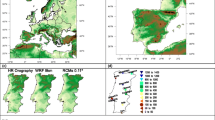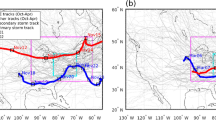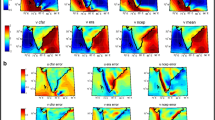Abstract
Wind extremes have consequences for renewable energy sectors, critical infrastructures, coastal ecosystems, and insurance industry. Considerable debates remain regarding the impacts of climate change on wind extremes. While climate models have occasionally shown increases in regional wind extremes, a decline in the magnitude of mean and extreme near-surface wind speeds has been recently reported over most regions of the Northern Hemisphere using observed data. Previous studies of wind extremes under climate change have focused on selected regions and employed outputs from the regional climate models (RCMs). However, RCMs ultimately rely on the outputs of global circulation models (GCMs), and the value-addition from the former over the latter has been questioned. Regional model runs rarely employ the full suite of GCM ensembles, and hence may not be able to encapsulate the most likely projections or their variability. Here we evaluate the performance of the latest generation of GCMs, the Coupled Model Intercomparison Project phase 5 (CMIP5), in simulating extreme winds. We find that the multimodel ensemble (MME) mean captures the spatial variability of annual maximum wind speeds over most regions except over the mountainous terrains. However, the historical temporal trends in annual maximum wind speeds for the reanalysis data, ERA-Interim, are not well represented in the GCMs. The historical trends in extreme winds from GCMs are statistically not significant over most regions. The MME model simulates the spatial patterns of extreme winds for 25–100 year return periods. The projected extreme winds from GCMs exhibit statistically less significant trends compared to the historical reference period.










Similar content being viewed by others
References
An Y, Pandey MD (2005) A comparison of methods of extreme wind speed estimation. J Wind Eng Ind Aerodyn 93:535–545
Anastasiades G, McSharry PE (2013) Extreme value analysis for estimating 50 year return wind speeds from reanalysis data. Wind Energy 17:1231–1245
Born P, Viscusi WK (2006) The catastrophic effects of natural disasters on insurance markets. J Risk Uncertain 33:55–72
Bracegirdle TJ, Shuckburgh E, Sallee J-B et al (2013) Assessment of surface winds over the Atlantic, Indian, and Pacific Ocean sectors of the Southern Ocean in CMIP5 models: historical bias, forcing response, and state dependence. J Geophys Res Atmos 118:547–562
Coles S (2001) An introduction to statistical modeling of extreme values. Springer, London
Cook NJ (1982) Towards better estimation of extreme winds. J Wind Eng Ind Aerodyn 9:295–323
Cook NJ (2012) Rebuttal of “Problems in the extreme value analysis”. Struct Saf 34:418–423
Cook NJ (2014) Consolidation of analysis methods for sub-annual extreme wind speeds. Meteorol Appl 21:403–414
Coumou D, Rahmstorf S (2012) A decade of weather extremes. Nat Clim Change 2:491–496
Dee DP, Uppala SM, Simmons AJ et al (2011) The ERA-Interim reanalysis: configuration and performance of the data assimilation system. Q J R Meteorol Soc 137:553–597
Field CB, Barros V, Stocker TF, Dahe Q (2012) Managing the risks of extreme events and disasters to advance climate change adaptation: special report of the intergovernmental panel on climate change. Cambridge University Press, Cambridge
Ganguly AR, Kodra EA, Banerjee A et al (2014) Toward enhanced understanding and projections of climate extremes using physics-guided data mining techniques. Nonlinear Process Geophys 21:777–795
Giorgi F, Francisco R (2000) Uncertainties in regional climate change prediction: a regional analysis of ensemble simulations with the HADCM2 coupled AOGCM. Clim Dyn 16:169–182
Harris RI (1999) Improvements to the method of independent storms’. J Wind Eng Ind Aerodyn 80:1–30
Harris I (2005) Generalised Pareto methods for wind extremes. Useful tool or mathematical mirage? J Wind Eng Ind Aerodyn 93:341–360
Harris RI (2009) XIMIS, a penultimate extreme value method suitable for all types of wind climate. J Wind Eng Ind Aerodyn 97:271–286
Helsel DR, Hirsch RM (2002) Statistical methods in water resources. US Geological survey Reston, VA
Holmes JD, Moriarty WW (1999) Application of the generalized Pareto distribution to extreme value analysis in wind engineering. J Wind Eng Ind Aerodyn 83:1–10
Iles AC, Gouhier TC, Menge BA et al (2012) Climate-driven trends and ecological implications of event-scale upwelling in the California Current System. Glob Change Biol 18:783–796
Kao S-C, Ganguly AR (2011) Intensity, duration, and frequency of precipitation extremes under 21st-century warming scenarios. J Geophys Res Atmos 116:D16119. doi:10.1029/2010JD015529
Kent EC, Fangohr S, Berry DI (2013) A comparative assessment of monthly mean wind speed products over the global ocean. Int J Climatol 33:2520–2541
Kerr RA (2013) Forecasting regional climate change flunks its first test. Science 339:638
Kodra E, Ganguly AR (2014) Asymmetry of projected increases in extreme temperature distributions. Sci Rep 4:5884. doi:10.1038/srep05884
Kumar D, Kodra E, Ganguly AR (2014) Regional and seasonal intercomparison of CMIP3 and CMIP5 climate model ensembles for temperature and precipitation. Clim Dyn. doi:10.1007/s00382-014-2070-3
Makkonen L (2008) Problems in the extreme value analysis. Struct Saf 30:405–419
Makkonen L, Pajari M, Tikanmäki M (2013) Closure to “Problems in the extreme value analysis”(Struct. Safety 2008: 30: 405–419). Struct Saf 40:65–67
Moss RH, Edmonds JA, Hibbard KA et al (2010) The next generation of scenarios for climate change research and assessment. Nature 463:747–756
Palutikof JP, Brabson BB, Lister DH, Adcock ST (1999) A review of methods to calculate extreme wind speeds. Meteorol Appl 6:119–132
Pryor SC, Barthelmie RJ (2010) Climate change impacts on wind energy: a review. Renew Sustain Energy Rev 14:430–437
Pryor SC, Barthelmie RJ (2011) Assessing climate change impacts on the near-term stability of the wind energy resource over the United States. Proc Natl Acad Sci 108:8167–8171
Pryor SC, Barthelmie RJ (2013) Assessing the vulnerability of wind energy to climate change and extreme events. Clim Change 121:79–91. doi:10.1007/s10584-013-0889-y
Pryor SC, Barthelmie RJ, Young DT et al (2009) Wind speed trends over the contiguous United States. J Geophys Res Atmos 114:D14105. doi:10.1029/2008JD011416
Pryor SC, Barthelmie RJ, Clausen N-E et al (2012a) Analyses of possible changes in intense and extreme wind speeds over northern Europe under climate change scenarios. Clim Dyn 38:189–208
Pryor SC, Nikulin G, Jones C (2012b) Influence of spatial resolution on Regional Climate Model derived wind climates. J Geophys Res Atmos 117:D03117. doi:10.1029/2011JD016822
Racherla PN, Shindell DT, Faluvegi GS (2012) The added value to global model projections of climate change by dynamical downscaling: a case study over the continental US using the GISS-ModelE2 and WRF models. J Geophys Res Atmos 117:D20118. doi:10.1029/2012JD018091
Rogelj J, Meinshausen M, Knutti R (2012) Global warming under old and new scenarios using IPCC climate sensitivity range estimates. Nat Clim Change 2:248–253
Sims R, Schock R, Adegbululgbe A et al (2007) In: Metz B, Davidson OR, Bosch PR, Dave R, Meyer LA (eds) Energy supply in climate change 2007: mitigation contribution of working group III fourth assessment report of the IPCC. Cambridge University Press, Cambridge, United Kingdom and New York, USA
Solomon S, Qin D, Manning M, et al (2007) Climate Change 2007. The Physical Science basis: Summary for policymakers. Contribution of Working Group I to the Fourth Assessment Report of the Intergovernmental Panel on Climate Change. Clim. Change 2007 Phys. Sci. Basis Summ. Policymakers Contrib. Work. Group Fourth Assess. Rep. Intergov. Panel Clim. Change
Sonali P, Nagesh Kumar D (2013) Review of trend detection methods and their application to detect temperature changes in India. J Hydrol 476:212–227
Stocker TF, Dahe Q, Plattner G-K (2013) Climate change 2013: the physical science basis. Work. Group Contrib. Fifth Assess. Rep. Intergov. Panel Clim. Change Summ. Policymakers IPCC 2013
Swart NC, Fyfe JC (2011) Ocean carbon uptake and storage influenced by wind bias in global climate models. Nat Clim Change 2:47–52
Taylor KE (2001) Summarizing multiple aspects of model performance in a single diagram. J Geophys Res Atmos 1984–2012 106:7183–7192
Taylor KE, Stouffer RJ, Meehl GA (2012) An overview of CMIP5 and the experiment design. Bull Am Meteorol Soc 93:485–498
Torrielli A, Repetto MP, Solari G (2013) Extreme wind speeds from long-term synthetic records. J Wind Eng Ind Aerodyn 115:22–38
Van den Brink HW, Können GP (2008) The statistical distribution of meteorological outliers. Geophys Res Lett 35
Van Vuuren DP, Edmonds J, Kainuma M et al (2011) The representative concentration pathways: an overview. Clim Change 109:5–31
Vautard R, Cattiaux J, Yiou P et al (2010) Northern Hemisphere atmospheric stilling partly attributed to an increase in surface roughness. Nat Geosci 3:756–761
Wallcraft AJ, Kara AB, Barron CN et al (2009) Comparisons of monthly mean 10 m wind speeds from satellites and NWP products over the global ocean. J Geophys Res Atmos 114:D16109. doi:10.1029/2008JD011696
Whalen TM, Savage GT, Jeong GD (2004) An evaluation of the self-determined probability-weighted moment method for estimating extreme wind speeds. J Wind Eng Ind Aerodyn 92:219–239
Wilks DS (2011) Statistical methods in the atmospheric sciences
Yang X-Y, Huang RX, Wang DX (2007) Decadal changes of wind stress over the Southern Ocean associated with Antarctic ozone depletion. J Clim 20:3395–3410
Acknowledgments
The research was primarily funded by the United States National Science Foundation Expeditions in Computing Grant # 1029711, as well as Northeastern University’s Tier 1 Grant from the Office of the Provost, and the Varahamihir Research Fellowship awarded to the second author by the Government of India. The climate model data sets were downloaded from the Program for Climate Model Diagnosis and Intercomparison (PCMDI) archive of the US Department of Energy’s Lawrence Livermore National Laboratory.
Author information
Authors and Affiliations
Corresponding author
Rights and permissions
About this article
Cite this article
Kumar, D., Mishra, V. & Ganguly, A.R. Evaluating wind extremes in CMIP5 climate models. Clim Dyn 45, 441–453 (2015). https://doi.org/10.1007/s00382-014-2306-2
Received:
Accepted:
Published:
Issue Date:
DOI: https://doi.org/10.1007/s00382-014-2306-2




